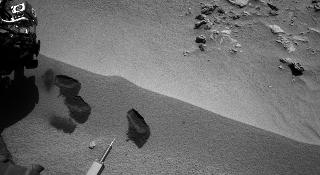
Three bite marks left in the Martian ground by the scoop on the robotic arm of NASA's Mars rover Curiosity are visible in this image taken by the rover's right Navigation Camera during the mission's 69th Martian day, or sol (Oct. 15, 2012). Photo: NASA/JPL-Caltech.
LOS ANGELES (AFP): NASA's Mars rover has swallowed its first scoopful of dirt from the Red Planet's surface -- and found some bright-coloured objects that experts briefly thought might be man-made, the US space agency said.
In an update on Thursday on Curiosity's two-and-a-half month old mission, NASA said its Chemistry and Mineralogy (CheMin) instrument, deep in the car-sized rover's belly, will analyze the soil to learn more about its make-up.
Some experts wondered if one of the bright-coloured objects -- seen on a photo of a scoop hole in the Martian soil -- could be man-made, like an object seen earlier this month thought to be plastic from the rover itself.
"We began to see some bright flecks in the scoop areas," Curiosity's project scientist told reporters in Pasadena, California, adding: "The science team started calling them schmutz."
Some suggested they could be man-made, but following discussions between scientists and engineers, there was a "strong consensus" that they were indigenous to Mars.
This conclusion was backed by the fact that the objects were left visible at the bottom of holes left by the rover's scoop, meaning they were normally underneath the planet's surface.
"We can't rule out that they're something man-made but we don't think that they are," he said.
Last week, NASA determined that a bright object observed on the ground near the robot several days previously was a bit of plastic that may have dropped from the rover itself, and did not jeopardize the rover's operations.
"The rover team's assessment is that the bright object is something from the rover, not Martian material," the mission said at the time. "It appears to be a shred of plastic material, likely benign."
But for the scientists, the first use of the CheMin device, to analyze the mineral make-up of the Red Planet's soil -- is a major milestone.
Curiosity is on a two-year, USD 2.5 billion mission to investigate whether it is possible to live on Mars and to learn whether conditions there might have been able to support life in the past.
 Previous Article
Previous Article Next Article
Next Article













The Indian Air Force, in its flight trials evaluation report submitted before the Defence Ministry l..
view articleAn insight into the Medium Multi-Role Combat Aircraft competition...
view articleSky enthusiasts can now spot the International Space Station (ISS) commanded by Indian-American astr..
view article